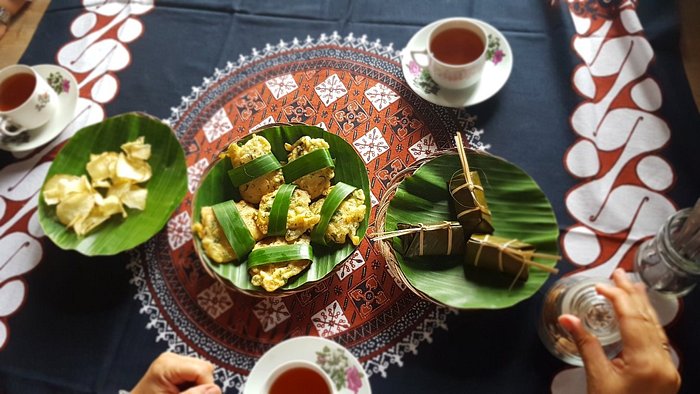Indonesian cuisine is as varied as the thousands of islands that make up the archipelago. Indonesia as a concept is relatively new, so what we think of as Indonesian food encompasses thousands of years of individuality along with different foreign influences.
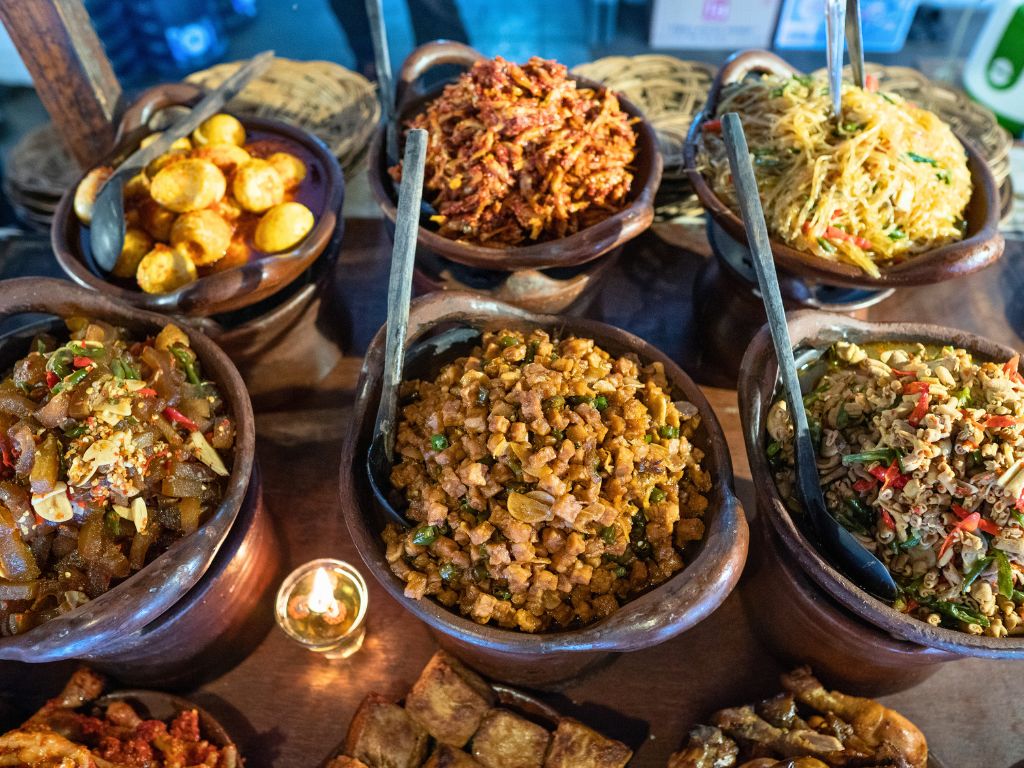
This makes it sound far more complicated than Indonesian food cuisine actually is, which is pretty easy to navigate once you know the basics. Let’s dig in and explore all the tasty things you can try if you’re adventuring in this fascinating country:
An Introduction to Indonesian Cuisine
As we mentioned already, there is a lot of diversity within Indonesian cuisine. The natural landscapes and indigenous food sources vary across the islands, as well as religion and external influences, so it’s not surprising that there is a huge number of different dishes and flavor profiles on offer.
Rice
The main food staple for centuries in Indonesia was rice. Paddy fields were established all over the Indonesian archipelago very early, with the hot temperatures and regular rain creating ideal conditions for rice cultivation.
Even though the introduction of wheat-based products like noodles, breads and crackers by the Dutch and Chinese proved extremely popular, rice is still the primary staple. In fact, often noodles are served as a side to rice dishes as the concept of not having rice at a meal is so odd!
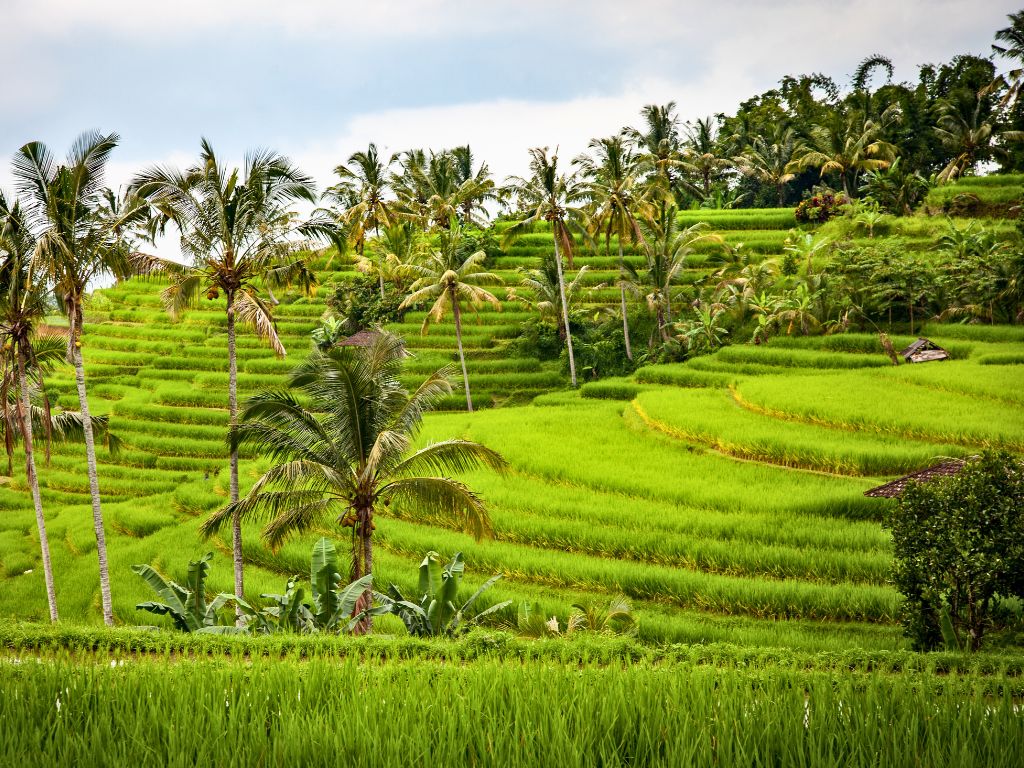
Meat
Historically there has always been a lot of meat in the Indonesian diet, with evidence of water buffalo, pigs and goats raised as a food source going back a long way. Today you are most likely to see dishes made with chicken and beef, but goat and duck are also popular.
If you are in a part of Indonesia that is primarily Muslim, such as Java, then you will not see pork on the menu, but in other places like Bali where there is a Hindu majority, you will find pork and boar dishes – the pig roast (babi guling) is particularly popular.
Of course, being surrounded by water, fish also features prominently in Indonesian cuisine, both seafood and freshwater fish.
Vegetables and Vegetarian Food
It is very easy to be a vegetarian in Indonesia. There is a huge range of vegetables that grow here, from yams, sweet potato and taro to all sorts of leafy greens, cucumbers, tomatoes and fruits. Beans are featured in popular dishes, as is the native coconut.
In addition, soy-based meat alternatives are very common. The Chinese introduced tofu to the Indonesian islands around the 15th century along with soy sauce and noodles, sharing the techniques required to process soybeans. On the island of Java another soy-based product, tempeh was created from soybeans, which are fermented to create a particular texture and flavor.
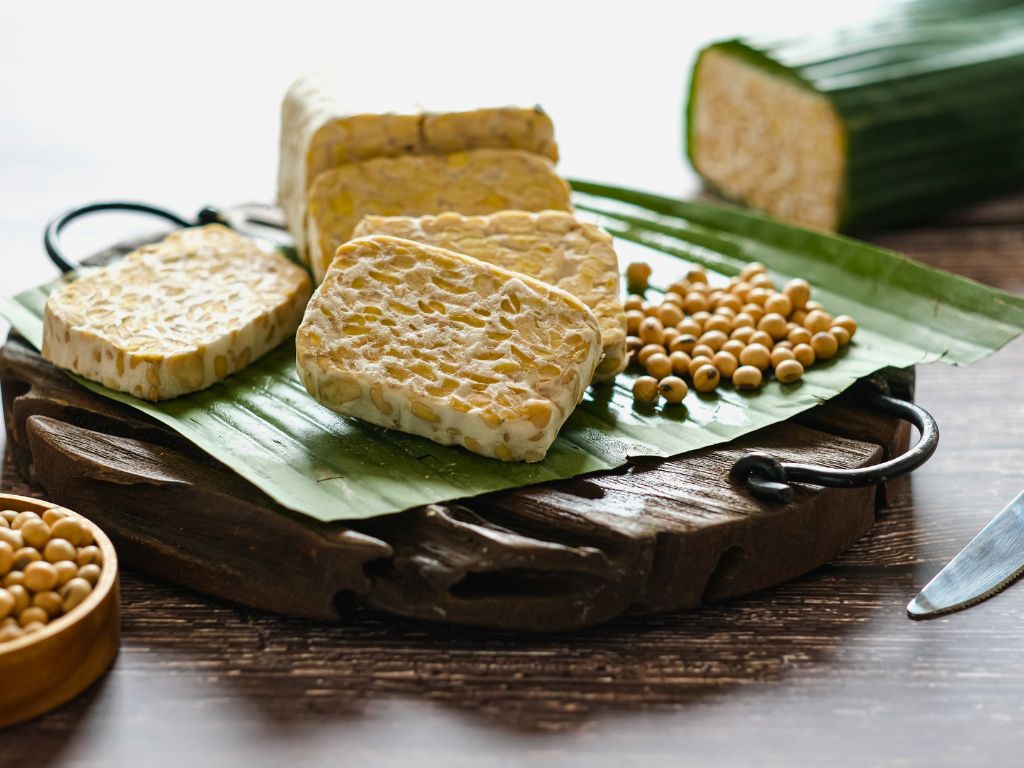
It is not clear if tempeh was an accident as a by-product of tofu production or if the Javanese were already making it with the native black soybean, but it is indisputable that tempeh is an Indonesian creation.
Both tempeh and tofu are used in many dishes so there are many options for vegetarians. However, most Indonesians are not strict with this, so the use of concentrated shrimp paste (terasi) as a flavor enhancer in peanut sauce, sambal chili sauce and more is very common.
Essential Indonesian Ingredients
While there are regional variations, in general the following ingredients are always going to be present at meals in some form:
Kecap Manis
Regular soy sauce (kecap asin) was introduced by the Chinese, but the Indonesians took this and adapted it to their tastes. Palm sugar was added to create a thicker, more dense sauce which is used on everything.
You’ll find bottles of kecap manis on tables like ketchup in the US as well as in every kitchen. It is used as the basis for marinades, as a sauce and as a seasoning when cooking.
Sambal
Chilis were not native to Indonesia, they were brought by Spanish and Portugese traders in the 16th century. Other spices were native so locals had always had a fondness for spicy flavors, but the chili pepper fast became the top choice.
Sambal is a chili sauce or paste, mixed with other ingredients such as garlic, ginger, shallots, palm sugar and lime juice. No sambal is quite the same as another, there are hundreds of versions all over the archipelago, and everyone claims to have the best one!
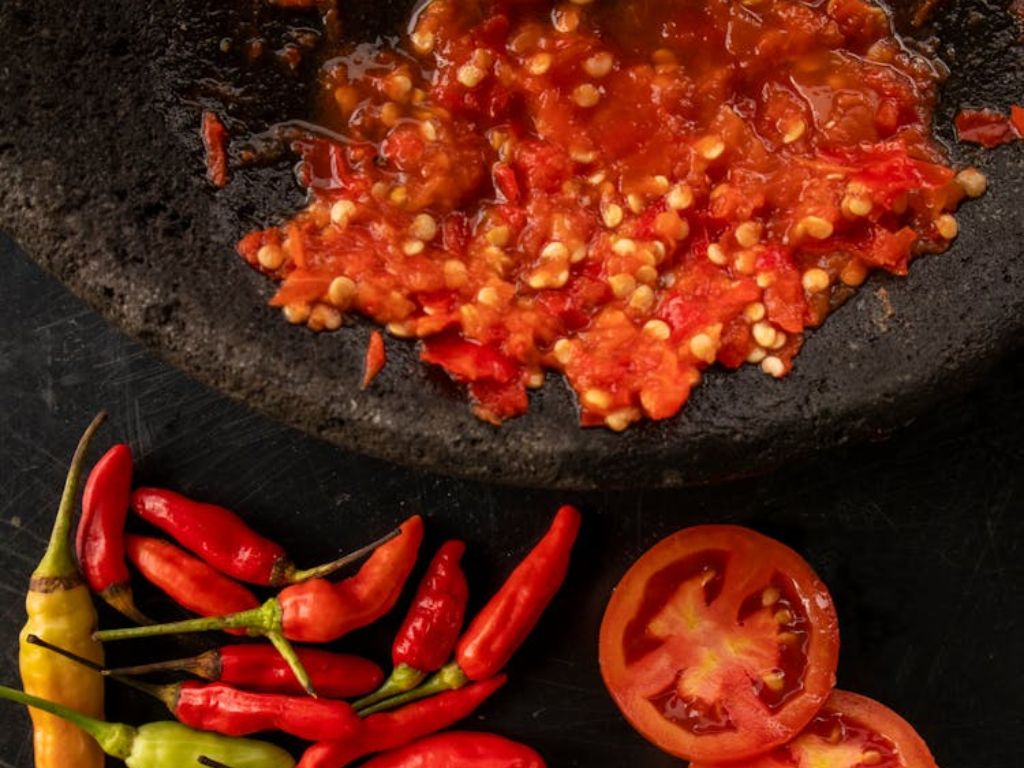
The one thing they all have in common is that they are HOT, so if you are not used to spicy food, go easy when first trying it.
Coconut
Indonesia produces a huge number of coconuts and they have always been an important part of life here. Not only do the coconuts themselves provide sustenance, the trees themselves and coconut skins were used to build homes and other essential items.
Coconut milk and the shredded flesh are used in both sweet and savory dishes, coconut oil is widely used and coconut sugar (a palm sugar made from coconut trees) is a central ingredient in many cakes and pastries.
Peanuts
Brought to Indonesia from Mexico by those ever-adventurous Spanish and Portuguese sailors, peanuts grow very well in tropical climates and were fast adopted as a staple ingredient.
You’ll find roasted peanuts used as garnishes as well as being added to marinades and sauces, and peanut oil is a common cooking oil here.
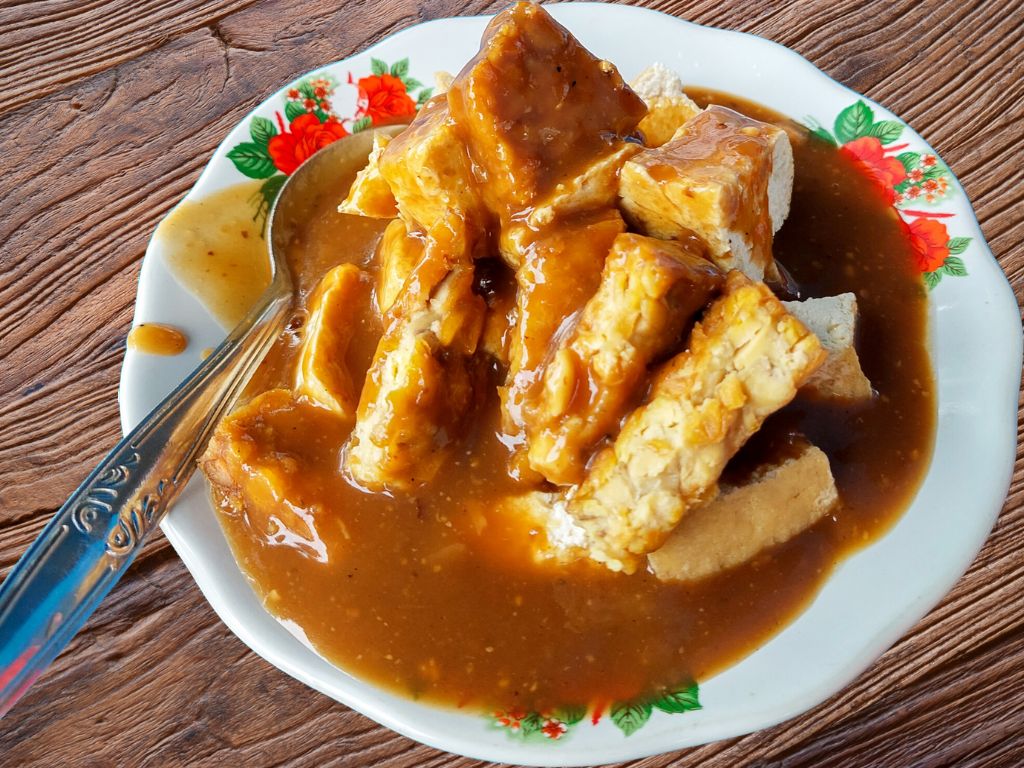
Peanut sauce (bumbu kacang) is made with ground peanuts and a combination of other spices, garlic, kecap manis and more to create a thickened sauce. Not as sweet as you might expect, the flavor combination is used on all sorts of dishes and is absolutely delicious!
Indonesian Food Names
Helpfully most of the common Indonesian dishes are named for their principal ingredient and the cooking method, so if you have these noted, you will be able to understand menus that much more.
Cooking methods:
- Goreng – fried
- Tumis – stir fried (Chinese-style)
- Bakar – grilled
- Panggang – baked or roasted
- Rebus – boiled
- Kukus – steamed
- Soto – soup
- Sate – grilled meat skewers
Food types:
- Nasi – rice
- Ayam – chicken
- Mie – noodles
- Ikan – fish
- Udang – shrimp
- Uduk – coconut
- Babi – pork
- Bebek – duck
So the famous Nasi Goreng is literally fried rice, Babi Panggang is roasted pig, Ayam Goreng is fried chicken and so on. There is of course a lot more to the Indonesian language, but this is a good starting point when deciding what to eat.
Must-Try Indonesian Dishes
Our recommendation would always be to ask your tour guide or the restaurant staff what you should eat, with all the different local specialities there will always be something new to try! However, these are the must-try dishes in our opinion:
Nasi Goreng
Probably the most well-known Indonesian dish, Nasi Goreng is super tasty fried rice. Made with a base of stir-fried vegetables, meat or seafood, and served with a fried egg on top, Nasi Goreng is usually served with a pickled vegetable salad.
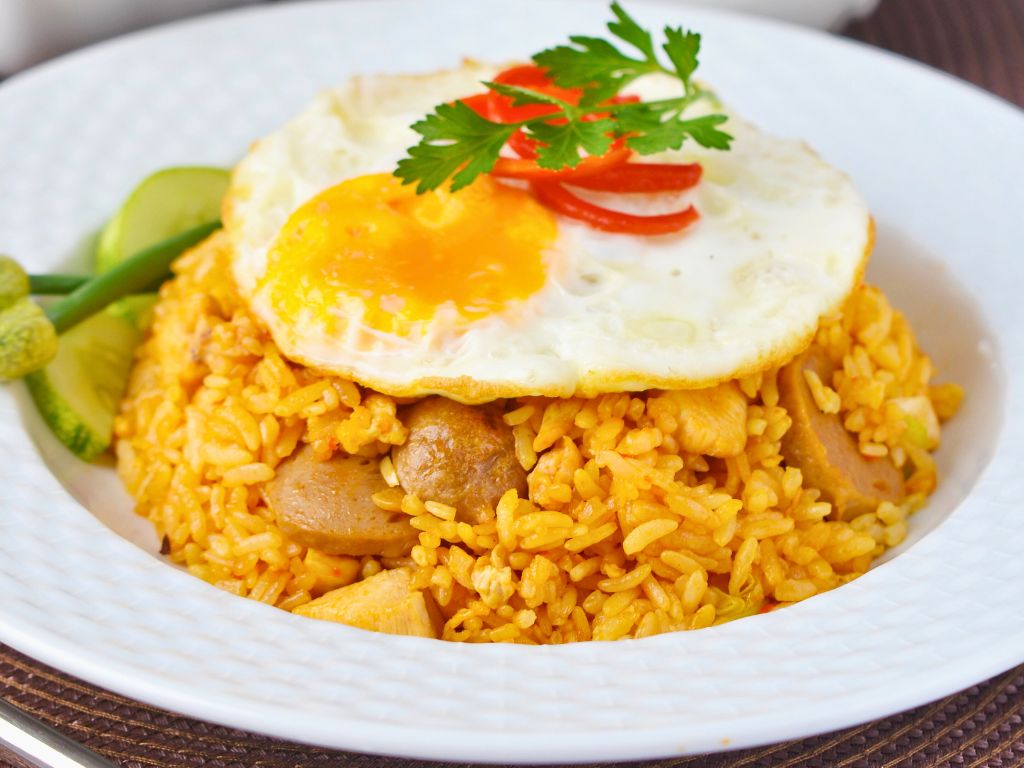
The idea behind the dish is to use up what you have, so each Nasi Goreng is a little different. The sweet soy sauce distinctive to Indonesia gives the fried rice a richer and stronger flavor, you can’t miss it!
Sate
Sate (Satay) is a classic Indonesian dish made with marinated meat grilled on skewers and topped with a mix of peanut sauce and soy sauce. All sorts of meats are used as well as fish and tofu and the sauce generally isn’t super spicy, but some local variations add sambal to the marinade so check in advance if you’re unsure.
Gado Gado
Gado-Gado is a salad made with mixed vegetables, such as bean sprouts, steamed potato, cabbage and cucumber. To this base is added fried tofu and/or tempeh, boiled egg and sometimes rice cakes, before everything is topped with peanut sauce.
Often served with steamed rice and a popular street food, try Gado Gado with Krupuk, Indonesian crispy crackers for a different texture.
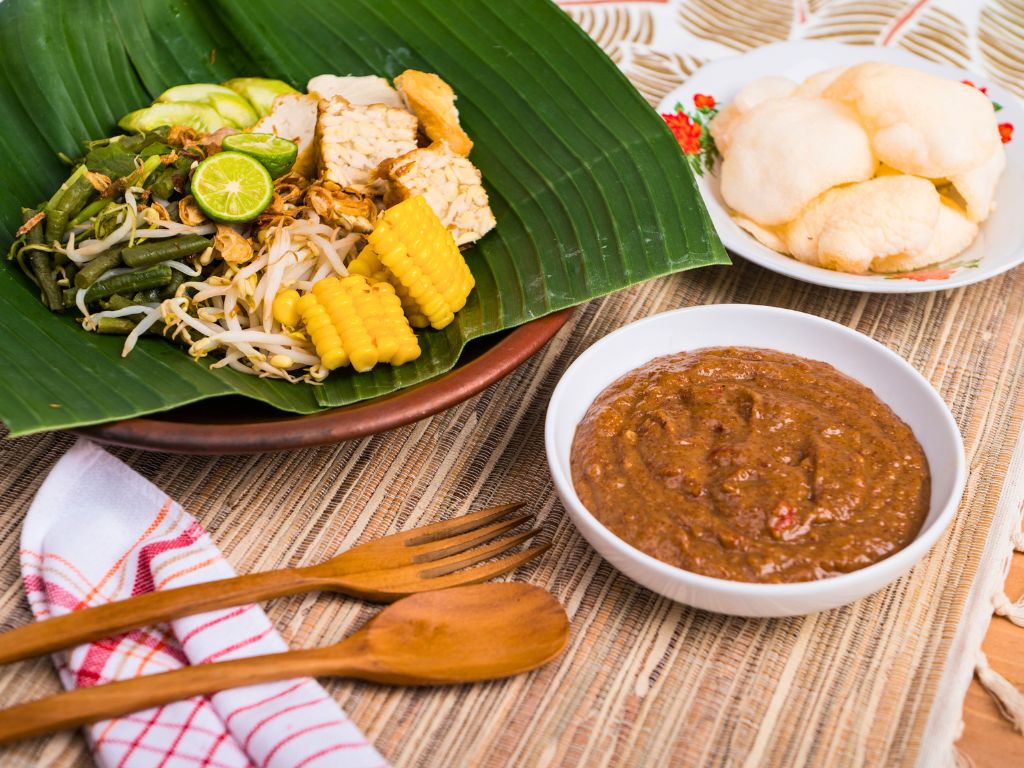
Rendang
Rendang, or Beef Rendang is the other best known Indonesian dish. Originally from Sumatra, beef is rubbed with a mix of spices before being cooked slowly in coconut milk. This process partially dehydrates the beef, making it last for weeks if made correctly. This was very important in the centuries before refrigeration was invented!
Rendang is still a very special dish in Indonesian cuisine, combining the traditional use of coconut milk and native spices from the Spice Islands. Often described as a beef stew, rendang is drier and less saucy than this implies.
Soto
Soto means ‘soup’ in Indonesian, specifically a traditional soup (soups with a foreign influence are called sop). There are many different versions but they will generally come with a base of meat broth or coconut milk, with different vegetables, noodles and a protein. Chicken is common but you’ll also find eggs, beef, rice cakes and offal versions.
Bakso
Bakso technically refers to a particular style of meatball, but the meatball soup dish where they are primarily served is also called Bakso. The meatballs are generally made of beef, but you can find chicken, fish and shrimp versions as well.
The meatballs are added to broth along with noodles, vegetables, tofu and topped with fried shallots. This is a really comforting dish, which really hits the spot after a long day exploring!
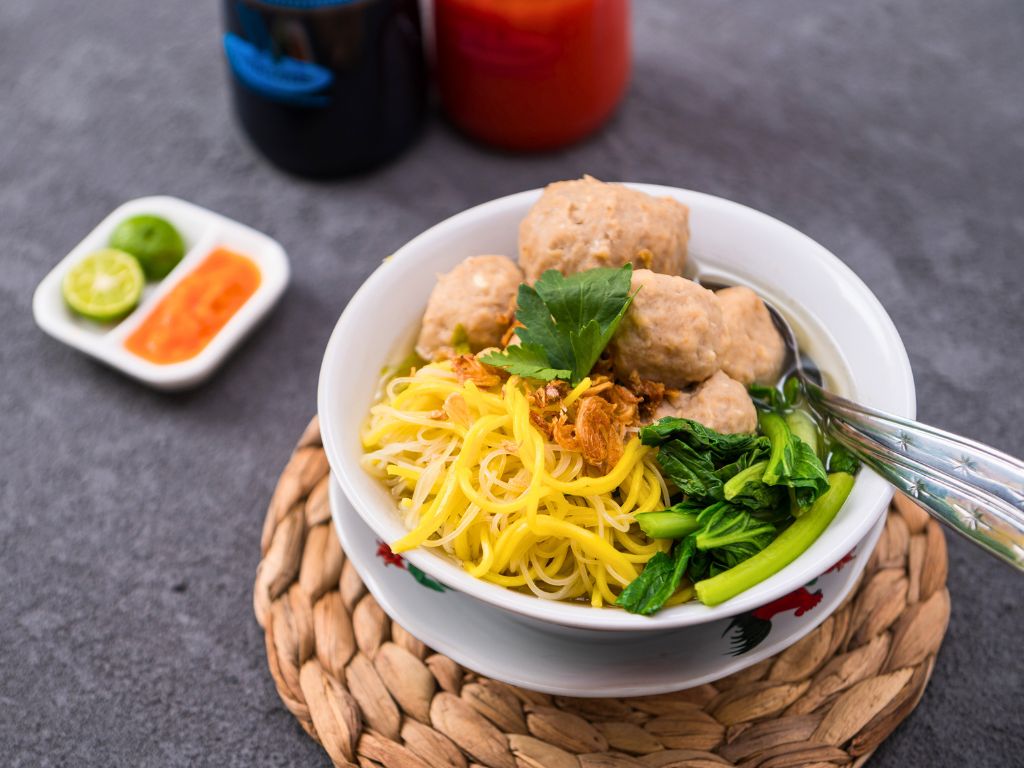
We love Indonesian cuisine, the fresh, high quality ingredients and long history of using spices has resulted in a varied and exciting food culture. If you want to learn more about the local food traditions, and taste some of this incredible food for yourself, you have to join us on our upcoming Indonesian adventure – click here to find out more or get in touch today to ask us any questions you may have.

